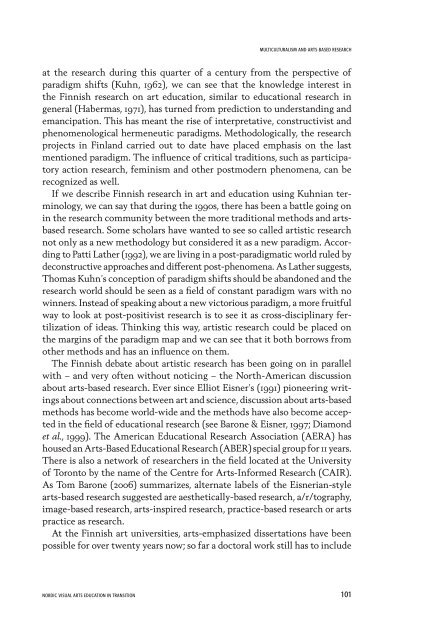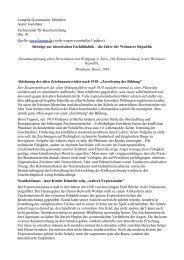Research in Visual Arts Education - The National Society for ...
Research in Visual Arts Education - The National Society for ...
Research in Visual Arts Education - The National Society for ...
Create successful ePaper yourself
Turn your PDF publications into a flip-book with our unique Google optimized e-Paper software.
MULTICULTURALISM AND ARTS-BASED RESEARCH<br />
at the research dur<strong>in</strong>g this quarter of a century from the perspective of<br />
paradigm shifts (Kuhn, 1962), we can see that the knowledge <strong>in</strong>terest <strong>in</strong><br />
the F<strong>in</strong>nish research on art education, similar to educational research <strong>in</strong><br />
general (Habermas, 1971), has turned from prediction to understand<strong>in</strong>g and<br />
emancipation. This has meant the rise of <strong>in</strong>terpretative, constructivist and<br />
phenomenological hermeneutic paradigms. Methodologically, the research<br />
projects <strong>in</strong> F<strong>in</strong>land carried out to date have placed emphasis on the last<br />
mentioned paradigm. <strong>The</strong> <strong>in</strong>fluence of critical traditions, such as participatory<br />
action research, fem<strong>in</strong>ism and other postmodern phenomena, can be<br />
recognized as well.<br />
If we describe F<strong>in</strong>nish research <strong>in</strong> art and education us<strong>in</strong>g Kuhnian term<strong>in</strong>ology,<br />
we can say that dur<strong>in</strong>g the 1990s, there has been a battle go<strong>in</strong>g on<br />
<strong>in</strong> the research community between the more traditional methods and artsbased<br />
research. Some scholars have wanted to see so called artistic research<br />
not only as a new methodology but considered it as a new paradigm. Accord<strong>in</strong>g<br />
to Patti Lather (1992), we are liv<strong>in</strong>g <strong>in</strong> a post-paradigmatic world ruled by<br />
deconstructive approaches and different post-phenomena. As Lather suggests,<br />
Thomas Kuhn’s conception of paradigm shifts should be abandoned and the<br />
research world should be seen as a field of constant paradigm wars with no<br />
w<strong>in</strong>ners. Instead of speak<strong>in</strong>g about a new victorious paradigm, a more fruitful<br />
way to look at post-positivist research is to see it as cross-discipl<strong>in</strong>ary fertilization<br />
of ideas. Th<strong>in</strong>k<strong>in</strong>g this way, artistic research could be placed on<br />
the marg<strong>in</strong>s of the paradigm map and we can see that it both borrows from<br />
other methods and has an <strong>in</strong>fluence on them.<br />
<strong>The</strong> F<strong>in</strong>nish debate about artistic research has been go<strong>in</strong>g on <strong>in</strong> parallel<br />
with – and very often without notic<strong>in</strong>g – the North-American discussion<br />
about arts-based research. Ever s<strong>in</strong>ce Elliot Eisner’s (1991) pioneer<strong>in</strong>g writ<strong>in</strong>gs<br />
about connections between art and science, discussion about arts-based<br />
methods has become world-wide and the methods have also become accepted<br />
<strong>in</strong> the field of educational research (see Barone & Eisner, 1997; Diamond<br />
et al., 1999). <strong>The</strong> American <strong>Education</strong>al <strong>Research</strong> Association (AERA) has<br />
housed an <strong>Arts</strong>-Based <strong>Education</strong>al <strong>Research</strong> (ABER) special group <strong>for</strong> 11 years.<br />
<strong>The</strong>re is also a network of researchers <strong>in</strong> the field located at the University<br />
of Toronto by the name of the Centre <strong>for</strong> <strong>Arts</strong>-In<strong>for</strong>med <strong>Research</strong> (CAIR).<br />
As Tom Barone (2006) summarizes, alternate labels of the Eisnerian-style<br />
arts-based research suggested are aesthetically-based research, a/r/tography,<br />
image-based research, arts-<strong>in</strong>spired research, practice-based research or arts<br />
practice as research.<br />
At the F<strong>in</strong>nish art universities, arts-emphasized dissertations have been<br />
possible <strong>for</strong> over twenty years now; so far a doctoral work still has to <strong>in</strong>clude<br />
NORDIC VISUAL ARTS EDUCATION IN TRANSITION 101



